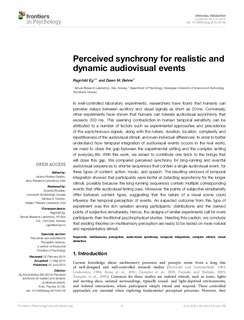| dc.description.abstract | In well-controlled laboratory experiments, researchers have found that humans can perceive delays between auditory and visual signals as short as 20 ms. Conversely, other experiments have shown that humans can tolerate audiovisual asynchrony that exceeds 200 ms. This seeming contradiction in human temporal sensitivity can be attributed to a number of factors such as experimental approaches and precedence of the asynchronous signals, along with the nature, duration, location, complexity and repetitiveness of the audiovisual stimuli, and even individual differences. In order to better understand how temporal integration of audiovisual events occurs in the real world, we need to close the gap between the experimental setting and the complex setting of everyday life. With this work, we aimed to contribute one brick to the bridge that will close this gap. We compared perceived synchrony for long-running and eventful audiovisual sequences to shorter sequences that contain a single audiovisual event, for three types of content: action, music, and speech. The resulting windows of temporal integration showed that participants were better at detecting asynchrony for the longer stimuli, possibly because the long-running sequences contain multiple corresponding events that offer audiovisual timing cues. Moreover, the points of subjective simultaneity differ between content types, suggesting that the nature of a visual scene could influence the temporal perception of events. An expected outcome from this type of experiment was the rich variation among participants' distributions and the derived points of subjective simultaneity. Hence, the designs of similar experiments call for more participants than traditional psychophysical studies. Heeding this caution, we conclude that existing theories on multisensory perception are ready to be tested on more natural and representative stimuli. | nb_NO |

